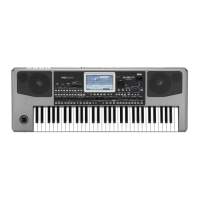231
Sampling mode
Entering and exiting the Sampling mode
Reference
The Sampling mode allows you to create new Samples, new Mul-
tisamples and new synced Audio Grooves. You can load Sam-
ples, Multisamples, Sounds and banks of Sounds from various
formats.
Pa900 can read common file formats, like WAV, AIFF and SF2
files, and load data from Korg Trinity and Triton files.
To be used, Samples must be assigned to a Multisample or a
Drum Kit. A Multisample allows you to arrange samples into
separate zones of the keyboard. Drum Kits allows you to assign a
different sample to each note of the keyboard, with up to six
dynamic layers per note.
Multisamples can then be assigned to Sounds. Sounds created
with this function can be used as any ordinary Sound, and
assigned to any track.
Another powerful feature of the Sampling mode is the Time
Slice, that lets you add realism to MIDI tracks by creating Audio
Grooves.
Wa r ni ng : When loading a “.SET” folder containing User PCM
Samples, all existing User PCM Samples are deleted from memory.
Save them before loading the folder, by selecting the “PCM” option
during a Save All operation (see “Saving the full memory content”
on page 285 of the User’s Manual).
To see if a “.SET” folder contains User PCM Samples, open it and
look for a “PCM” folder.
Hint: If you want to load new User PCM Samples without deleting
the ones already contained in memory, load single Sounds instead
of a “.SET” folder.
Entering and exiting the Sampling mode
• While in Sound mode, press the RECORD button to enter in
Sampling mode.
• While in Sampling mode, press the RECORD button to exit the
Sampling mode, and return to the Sound mode.
Creating new Sounds from the Samples
Here is how to create a new Sounds from new Samples and Mul-
tisamples.
1. Create new Samples with the procedures described in the
following pages.
2. Select the Write command from the page menu to save the
Sample in edit. The Write Sample dialog box will appear
(see “Write Sample dialog box” on page 243). Assign a
name to the new Sample, and confirm saving.
3. After saving, you can load other files to create additional
Samples.
4. When you have created and saved all the needed Samples,
press the MENU button and go to the “Multisample” sec-
tion, to assign the Sample(s) to a Multisample. Assign each
Sample to a different keyboard zone of the Multisample.
5. When finished editing the Multisample, select the Write
command from the page menu. The Write Multisample
dialog box will appear (see “Write MultiSample dialog box”
on page 243). Assign a name to the new Multisample, and
save it to the internal memory.
6. Press RECORD to exit the Sampling mode and return to
the Sound mode.
7. Select an ordinary Sound similar to the one you want to
create.
8. Press MENU and go to the “Basic: OSC Basic” page (see
page 206). Select one of the available layers, then select the
RAM bank of Multisamples. Finally, select the new Multi-
sample.
9. Select the Write Sound command from the page menu, and
save the Sound to an empty User location.
10. If you want so, assign the new Sound to a track, then select
the “Write Performance”, “Write Current Style Settings” or
“Write STS” command from the page menu, to save the
Sound to a Performance, Style Settings or STS.
Sampling mode

